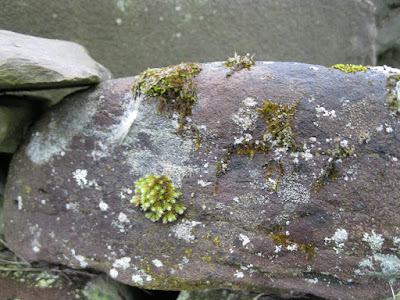
Today marks the beginning of the twelfth year of Plants and Stones, our garden blog. I braved the wind, rain and falling temperatures to go out and look for something exciting to start off 2019 with a bang. My hands were getting cold so I stopped by this stone wall. Built circa 2008 it has since become encrusted with all kinds of moss and lichens. Ed will claim that this is not a picture of a failed stone wall that he built. His walls are built from large scattered piles of stones that allow him to pick individual stones that will build a strong wall. This was never intended to be more than a temporary stone pile. As garden ground was cleared these stones were piled as they were found. There was no choice available to pick stones that were right. Ed thought for some time that this pile might fall. I never thought it would happen but in 2016 strong north winds pushed a section to a leaning overhanging position and eventually over it went. Now this fallen pile provides raw material for new carefully constructed walls.
Stones that already have been decorated by Mother Nature with mosses and lichens are treasures to a stone wall builder. The growth adds an additional consideration when placing the stone. It must be solidly placed in the wall while preserving the exposure to sunlight and moisture. Close to the ground seems like a good choice but just how these life forms grow remains a mystery.
This stone is interesting in a number of ways. Round stones are difficult to place in a wall. When one sets out to repair a section of an old wall that failed, a round rock is commonly found at the bottom of fallen section. The top knob on this one wildly increases the likelihood of a failed wall. This stone will better serve as a stone partially buried at the edge of a walking path in the new woodland garden. Such a placement will also preserve the various life forms making their homes on this stone.
We have attempted to learn more about lichens and moss. Articles that we find are filled with huge words whose meaning remains unknown. Anyone that knows the meaning of such words already knows a great deal about these plants. So we simply admire and speculate. It seems likely that creating the next generation is what is going on here. The bright colors are rarely seen but appear when the lichen is wet..
This view speaks volumes. A large collection of small stones can be seen in one section of the fallen pile. Placing these solidly in a wall would require a huge amount of time given the variation in thickness. Their presence is likely the location of the part of the wall that first moved tiny amounts when hit by strong winds. New paths will be edged with these stones. They will be buried out of sight but will form a solid boundary for the path. The end stones are the best ones placed in this pile. They will be moved to the reconstruction project along the property line. A properly built wall is planned to back the transplanted Arbutus already growing there. We have never seen Arbutus in the wild growing against a stone wall but think that the two will look grand together. The centuries old fallen wall presently there will be rebuilt with additional stones. We expect that any visual difference between the stones will quickly disappear. They are after all the same age. The only difference is how they spent the last century.




1 comment:
Happy New Year! Stone walls are the best--whether they're perfectly planned or casually constructed. Your walls are inspiring. Personally, I also welcome the mosses and the lichens--all over the garden, but particularly on the stones of the walls. It's fun to see mosses settling into the crevices of the lava rocks I use as mulch in my pots, too. Have you read "Gathering Moss," by Robin Wall Kimmerer? It seemed a little easier for me to understand than many other books about mosses. She's a great writer.
Post a Comment